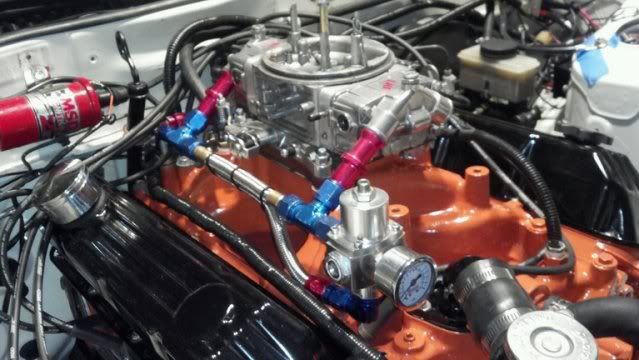scottylack
Well-Known Member
looking for a good Walbro for my 360/4bbl engine...any suggestions? Not sure if the high pressure ones are just made for EFI ?? thanks
Is that too much pressure?
What i read online is that you need to run a bypass regular and run a larger return than your feed. So like a An6 feed and an an8 return.
hey bill do you think a 1/2 in feed and a 1/2 in return will work this is what im trying to do now with the 392 pump.Good advice.
We run Walbro 392 pump on our turbocharged slant six, with Holley double-pumper 600 4-bbl and have ZERO problems using an Aeromotive regulator that adjusts the pressure down to 6psi with no boost, which the carburetor likes. The regulator has a 3/8" supply with a half-inch return, and that setup provides a steady 6-psi gauge reading, for the gas coming out of the regulator under all circumstances.
The secret to running a high-pressure pump is the regulator and the return line. We didn't get satisfactory results until we increased the return line from 3/8 to 1/2"... Don't ask me why; I can't answer that... I just know it worked.
Here's a photo...
hey bill do you think a 1/2 in feed and a 1/2 in return will work this is what im trying to do now with the 392 pump.
I agree bill the 1/2 line was already there on the car and the fuel sending unit was already 1/2 so I just decided the easyiest way would just put a 1/2 return nipple in the sending unit and run a line thanks.I can't see why that wouldn't work, but consider this: With 60psi pressure from the pump, why would you need a half-inch supply line? That is an AWFUL lot of gasoline (at 60 psi, I mean.) I can't imagine that a 3/8-line would be too small...
Food for thought...:coffee2:
I agree bill the 1/2 line was already there on the car and the fuel sending unit was already 1/2 so I just decided the easyiest way would just put a 1/2 return nipple in the sending unit and run a line thanks.
keep us informed and a few pics of your setup good luck and thanksthanks for your help...going to go with the Walbro 392, an Aeromotive bypass boost referenced regulator and a 1/2 return line!
thanks for your help...going to go with the Walbro 392, an Aeromotive bypass boost referenced regulator and a 1/2 return line!
A carbureted engine usually doesn't usually need the biggest, baddest EFI pump. Even a little pump will flow a lot of volume at 10 psi outlet. Walbro has flow curves. 1/2" lines sounds like overkill. I currently have a Walbro (190 lph?) on my 65 Dart w/ a carb. I have a 3/8" supply and 5/16" return. With no bypass regulator, it runs ~10 psi on the return. That is too much for a carb needle to handle, so I use an in-line Holley regulator (pressure-reducing, came w/ a blue pump) to reduce to ~5 psi at the carb. The EFI pump is for future FI.
I expect the 10 psi return is due to returning thru the 1/4" vent tube in the sender I used. Whatever your design, you might need to install some pressure gages, at least temporary, to tell what is going on.
on a N A engine and using the 13204 bypass regulator do you just plug the boost nipple?
what about the ignition set up? Anybody want to elaborate on a good system for a Paxton motor?

Yup, fuel pressure is rock solid. I used to have it mounted before the carb ( fuel pump to the fuel pressure regulator (FPR), then "Tee'd" off to the carb, with return), but found that I was having some percolation issues in the line between the FPR and carb that caused irregular fuel pressures. My engine bay gets VERY hot, and the problem was exagerated by the fact that the FPR was located so far away from the carb (inner fender, firewall mount is not nhra legal) so the line going from the FPR to the carb was over 3 feet long. Even though cool fuel was constantly flowing through the FPR the fuel inside the feed line was stagnate, which allowed it to get too hot. I tried several things to relieve the problem, including insulating the line, but nothing helped.
Earlier this year I stumbled on a thread on Yellowbullet about FPR locations that prompted me to research the idea more. Turns out that mounting the regulator after the carb has a few benefits over fender well mounting. The one benefit that caught my eye was that the carb would now get a cool fresh supply of fuel since all of the fuel sent by the pump is now sent straight through the fuel rail first, then to the FPR. It's just like an efi system. What this does is ensure that the float bowls are supplied with the freshest fuel possible, and that the bowls are filled first without having to pass through the FPR first, eliminating a possible restriction.
For me it was problem solved, no more issues. Glad too since I bracket race a lot and am always chasing consistency. Any more questions feel free to ask.
